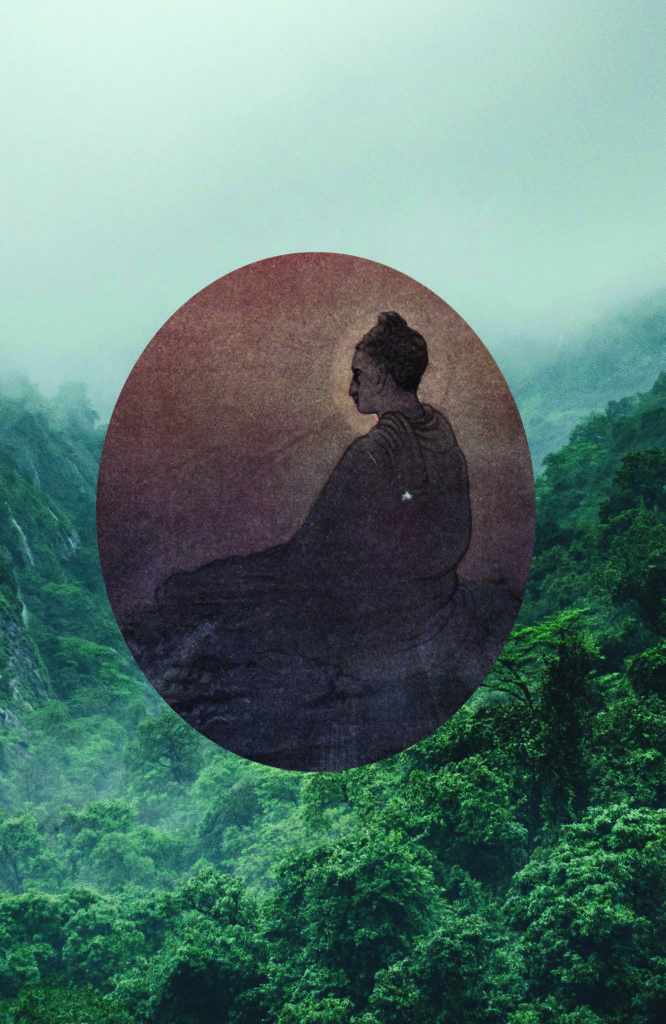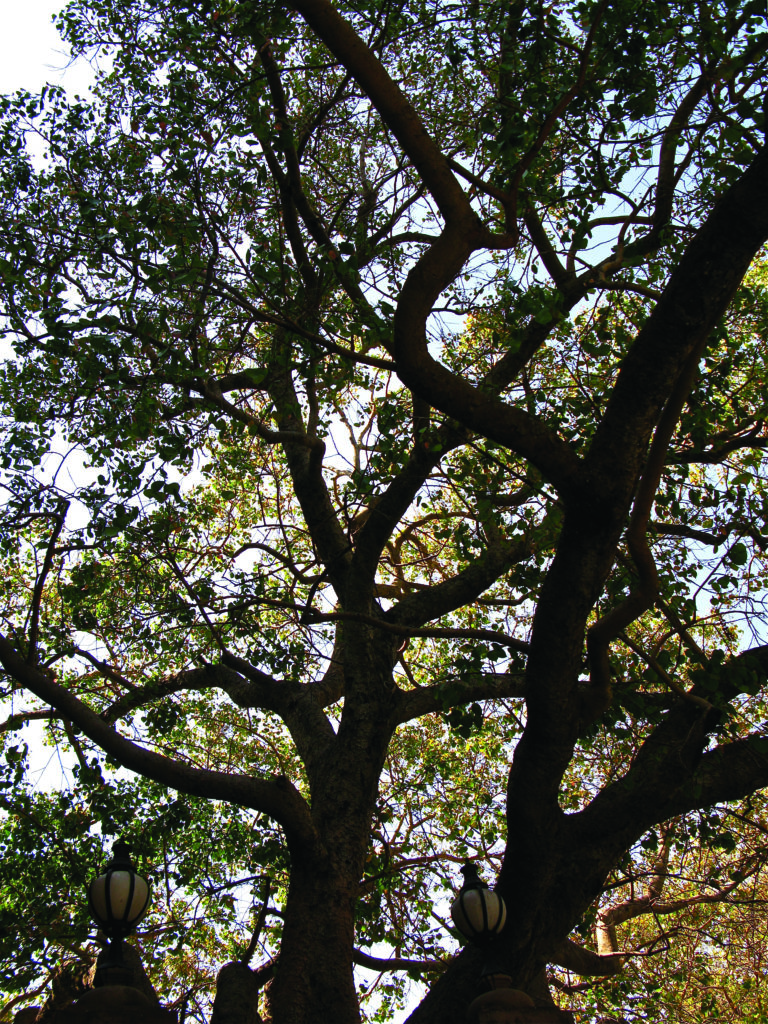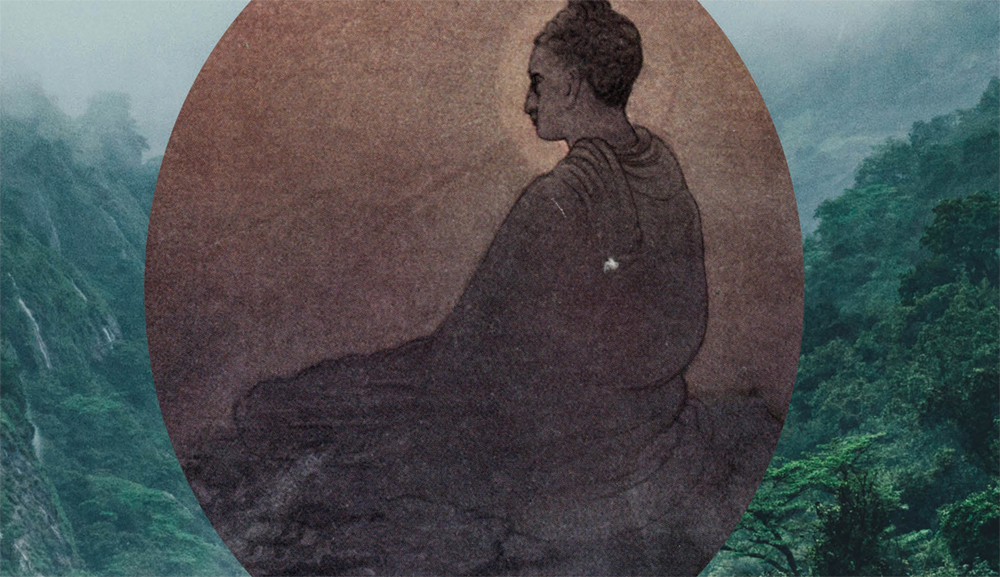
Before his enlightenment, the man who would be Buddha sat through a long dark night. This night didn’t span a known and reasonable number of hours following a particular day. According to ancient Buddhist texts, it lasted for seven weeks, or forty-nine days.
Just as Bible stories speak of forty days in the desert and so on, the invocation of forty-nine days is not meant to be taken literally but is believed by scholars to mean “a very long time.” And this is exactly how it feels to be deeply and completely in the dark, to sit in a place of vibrating, frightening uncertainty, your whole life and identity in question. It feels like forty-nine days.
People who are drawn to the great myth of the Buddha’s enlightenment tend to focus on the light. It seems incidental that it appeared in the midst of darkness. We may love the exotic details of the story: Siddhartha Gautama, an Indian prince, leaving palace and family to seek the ultimate wisdom. But in the end, he captured lightning in a bottle for all of us. We love a good story, redolent with spice-scented details of palaces and harems abandoned, of luxury traded for extreme asceticism. But life is hard, and time is short, and what we really want is the thing itself, the formula for ending suffering in all forms. We want the solution as widely advertised: completely universal, meant for distribution and consumption by everyone everywhere.
It takes a very long time, what feels more like forty years than forty days, to realize that the real goal of the quest was the darkness and solitude of the forest.
In the end, the Buddha’s questing led to a state of questioning, of opening up to life with an attitude of attentiveness and not knowing that would never end. After years of wandering and searching, finding and leaving great teachers, after attaining rare yogic states, the Buddha abandoned it all, quitting his companions and his extreme ascetic practice to go off alone. He sat down under the sheltering Bodhi tree, vowing to meditate until he found direct answers. He had enough words and thoughts, enough special states. He was carried into the forest by a deep wish for a direct encounter with reality. Why, for all his hard work and sacrifice and lofty attainments, did he still feel suffering and unease? Was peace and freedom possible? What was in the way?
His meditation was a way of questioning his life directly, not just thinking about it and analyzing it but seeing and feeling his experience calmly and clearly, without adding explanation or narrative. What thoughts and emotions and sensations were arising?
He sat still in the middle of an Indian forest, observing in the same way that Jane Goodall watched chimpanzees in the wild in Africa, not knowing what she would see, careful not to rush to judgment or conclusion but to go on seeing. The Buddha sat in the forest watching his experience until he, and life itself, became the question.
“Quiet friend who has come so far, feel how your breathing makes more space around you.” These lines from Rilke convey how it was at first—that is my projection. I cannot know the experience of a Indian prince turned yogi and seeker. But I do know how it feels to be sick of searching in the wrong direction, looking outside myself for easy answers. Along with everyone else who has lived, I know how it feels to face great uncertainty, to feel like a stranger in a strange world, every sense including the mind awake and alive. In such a state, we see the nature of grasping itself because it can find no object. In the pitch black of not knowing, our fear and our fantasies stand out.
In the Pali Canon, the Buddha describes his enlightenment in terms of military watches instead of hours. Like the ancient Jews, the Buddha divided his long night into three watches (the Romans used four), each representing the stretch of time a sentinel would be assigned to be on the lookout. Fresh insights are described with each watch.
During the first watch, as night fell and deepened, the Buddha saw his past lives in his mind’s eye, the endless cycle of his rebirths. We cannot know how the Buddha saw, but we can know those sleepless nights filled with pangs of regret and poignant sorrow, thinking of the passage of time and the mistakes we made, and then the further mistakes we made trying hard to fix our mistakes. We know how lonely and dense it feels to glimpse how we have been carried along passively. What would it mean to make this dreadful passage stop? What might it mean to be active? “Let this darkness be a bell tower and you the bell,” wrote Rilke.
The Buddha stayed still, watching thoughts and memories arise, experiencing joy and sadness and fear, determined to see more deeply. He didn’t know if the light of deeper insight would ever dawn. Maybe he would just keep seeing the cycles of rebirth, the endless repeating patterns of our lives. Yet towards the end of the second watch, he made out something new, as if his eyes were adjusting to the dark. He glimpsed the law of karma. Our actions have consequences, he saw, now and in the future.
The way we talk and act and live sends out ripples, and we cannot know in advance what consequence they might ultimately have. But we can speak and act and live in a more conscious way, understanding that the smallest gesture has impact. A smile or a piece of bread might save a life, a momentary meanness might cause lasting harm. The night went on. His enlightenment was not to be a single blinding flash that lit up the skies, but a series of illuminations in the midst of darkness. His quest came down to opening his heart and mind in the dark, seeking a truth that was deeper than karma, under the myriad ways over myriad lifetimes he tried to deal with his pain. He waited as patiently as the trees that sheltered him, refusing to try to speed up the process, consenting to open fully to the life that presented itself. And a new light dawned, building on the insights that came before. Enlightenment may not have been a flash of lightning but a great lightening: certainty about how to lift the burden of our ignorance and fear.
By the light of the morning star, he became the Buddha, the Awakened One. He saw clearly that under all our patterns and karma, at the root of all our stress and unease, there is a constant craving that is rooted in the ignorant belief that we are separate and at risk from the rest of life. But we can wake up from this delusion of separation and from the greed and fear that flow from it. We can be part of a greater life. “If you go off into the forest and get very quiet, you’ll come to understand that you’re connected with everything,” wrote Alan Watts.
In darkness in a forest, the Buddha discovered that there is no such thing as a truly separate self, that we are all inextricably interconnected with each other and with the rest of life. How can he not have been influenced by his surroundings? Our science is slowly rediscovering what indigenous people have always known: trees and other creatures are not individual beings but part of an interconnected community, inextricably nourishing and communicating and supporting one another. In his choice of meditation retreat, the Buddha could not be truly alone.
Ancient stories describe the Bodhi tree bursting into bloom and myriad living things also rejoicing at the Buddha’s arrival, rich evidence of the influence of indigenous culture that perceived and honored nature spirits. Even if he was somehow impervious to this influence, on the night of his enlightenment he died to a life of striving isolation and woke up to a living ecosystem. He took root in life, no longer striving for it to be otherwise, and at the same time he vanished into something larger.
And what happened next? He stood and went walking. He had no destination. What else could he have done? He was literally aimless, his great goal fulfilled, as he described it in the Pali Canon: “the holy life fulfilled, the task done. There is nothing further for this world.” Nothing further for his old world, that is. The world of creation welcomed his awakening with wild joy and celebration. And for seven days before he left the forest, the Awakened One stood and gazed at the tree that sheltered and supported him, offering it the finest, and only, gift he had to give: the gift of his attention. From that day on, everything he did and said would express his awareness of interconnection. Universal truths are not thoughts, the Buddha saw. They are the irrevocable conditions of our lives. Change is inevitable, the Buddha saw. Everything is impermanent. But he also woke up to the power of living in a shared world, nurtured and sustained by the earth.
During the long journey of his night, there came a point where he was completely overwhelmed. As he sat mediatating in the dark, the devil Mara sent visions intended to unseat him. First he tried temptation, flashing images of the Buddha as a great leader, rich and famous and powerful beyond measure, surrounded by gorgeous women. All of this could be his, Mara indicated, if the Buddha would just get up from his seat and go claim it. But he went on sitting. When temptation didn’t work, Mara tried fear, sending visions of vast armies howling for blood. These projections must have been terrible in the night, causing waves of longing and panic. And yet the Buddha did not move. Instead, he slowly reached down and touched the earth.
The classical explanation of this famous gesture is that he was asking the earth to support him and bear witness to his lifetimes of effort. Not his blinding brilliance or unique talent, but his perseverance, his persistent willingness to try and try to wake up to a greater life.
Touching the earth symbolized the Buddha’s abandonment of ego, his willingness to come down out of the isolation of his own narrative to join a living world. The Latin word humus, rich living soil, is related to humility. In times of overwhelm, the Buddha demonstrated, when the ego’s defenses fail us, we can take refuge in the simplest of human gestures. We can acknowledge something deeper than thought: our inextricable relationship with the rest of life. We tend to think of enlightenment as ascending a mountain, transcending all our worldly attachments and concerns. But the Buddha’s quest shows that we may actually awaken downward into life, descending from our heads into our true hearts, into the felt experience of being alive. It reveals that what may be essential in us is not a fixed thing, a cherished narrative, but our capacity to respond to a life that is constantly unfolding.
The Buddha could not imagine what his life would be like after enlightenment. What else could he do but go walking, looking at a new world with new eyes? Eventually the god Brahma, keeper of the teachings, would come to him and implore him to try teaching, to see that there were at least a few who didn’t have too much dust in their eyes to see. But for a long time, the Buddha just walked. How could he convey this freedom that he found? And yet his radiance, his warm and open way of being with life, was so striking that a man passing by stopped him in his tracks.
“What are you?” the man asked the Awakened One. “Are you a god?”
“No,” the Buddha replied, probably with a serene smile.
“An angel?”
“No.”
“Are you a wizard, then?”
“No.”
“Are you a man?”
“No.”
This last answer must have confounded the poor man. What was he? “I am awake,” said the Buddha.
True teachers surprise people and stir them up, filling them with questions, ultimately causing them to question themselves. The Buddha brought the stillness of the forest with him as he walked. He was so present and attentive that the other man felt safe enough to ask questions of him. And yet he represented something completely unknown. The man thought he might be an angel. In every tradition angels are radiant and beautiful but also terrifying, blazing through the fog of our illusions.

Ultimately, awakening is destructive, it is the eradication of what we imagined to be true. In the end, a quest is a questioning. The Buddha invited the man to wake up, to question everything he believed himself to be. Enlightenment is sometimes compared to a candle blowing out, sometimes to a fever breaking. Awakening is waking up from the stories we tell ourselves, the stories that separate us. But from that first walk, the Awakened One expressed a kind of kindness that literally shares a root with kin. All life and every being were kindred, intricately and inextricably related to him.
The Buddha drew the man—and uncounted others to him down to the present day—not because of what he possessed, precious jewels of wisdom from the East, but because of his liberation from separation. Tathagata, one of the titles the Buddha used when referring to himself, is believed to mean “one who has thus gone.” He had gone beyond the usual striving and constructs. He no longer lived in his own world but in a shared world. It could not be alien to him. From his first walk, he looked at everything and everyone as if it were family. This did not mean a snake was not a snake. It meant the snake was familiar to him. He could not mistake it for a stick.
How can we know any of this? The myth of the Buddha’s great quest and his awakening is very mysterious and faraway. But it is also an invitation to question what it means to be awake, to sit in the dark of our own not-knowing and see what we find. Slowly, we begin to realize that waking up involves waking up to the truth of who we are, and that means the whole truth, including our ignorance and pain, including the world around us that we don’t see.
It takes courage to sit in the dark, to be with our unknowing and go on seeing. We begin to see that we can own nothing, that everything comes from somewhere. We see that everything is in movement. There is nowhere to plant a flag. But as we awaken to this, a new kind of warmth and ease comes into our lives. We begin to understand that even on the darkest night, we can never really be alone.

